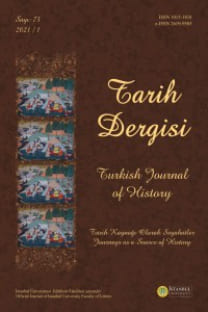Tasvirden Tahayyüle: Avrupa Resminde İnebahtı Muharebesi
İnebahtı Muharebesi, Kutsal İttifak, deniz resmi, ikonografi, sembolizm, ilahi müdahale
From Representation to Imagination: The Battle of Lepanto in European Painting
Battle of Lepanto, Holy League, maritime painting, symbolism, iconography, divine intervention,
___
- Angelini, Gianpaolo - Giuseppe Raimondi, La cappella del Collegio Ghislieri di Pavia, Como-Pavia: Edizioni Ibis, 2005.
- Bacon, Francis, “Of the True Greatness of Kingdoms and Estates”, The Works of Francis Bacon: Baron of Verulam, Viscount St. Albans, and Lord High Chancellor of England, Vol. II, London 1824.
- Beeching, Jack, The Galleys at Lepanto, Hutchinson, London 2007.
- Bostan, İdris, Kürekli ve Yelkenli Osmanlı Gemileri, Bilge Yayınevi, İstanbul 2005.
- Braudel, Fernand, The Mediterranean and the Mediterranean World in the Age of Philip II, Harper Collins, New York 1992.
- Cervantes, Miguel de, “In which the captive recounts his life and adventures”, The History and Adventures of the Renowned Don Quixote, trans. Tobias Smollett, ed. O. M. Brack, Jr., The University of Georgia Press, Athens 2003.
- Contarini, Giampietro, Historia delle cose successe dal principio della guerra mossa da Selim Ottomano a Venetiani fino al di della gran giornata vittoriosa contra Turchi, Francesco Rampazetto, Venetia 1572.
- Çerçi, Faris, Gelibolulu Mustafa Âli ve Kühn-ül’Ahbâr’ında II. Selim, III. Murat ve III. Mehmet Devirleri, c. I, Erciyes Üniversitesi Yayınları, Kayseri 2000.
- Felibien, Andre, “Preface” in Felibien et al., Conferences de l’Academie royale de peinture et de sculpture, pendant l’annee 1667, F. Leonard, Paris 1668.
- Ferguson, George, Signs and Symbols in Christian Art, Oxford University Press, New York 1954.
- Hammer, Joseph von, Büyük Osmanlı Tarihi, c. VI, Üçdal İkra Okusan, İstanbul 1992.
- Howells, Richard, Visual Culture, Polity Press Blackwell, Cambridge 2003.
- İnalcık, Halil, ‘Lepanto in the Ottoman Documents’, IlMediterraneo nella seconda meta del 500 alla luce di Lepanto: atti del convegno di studi promosso e organizzato dalla Fondazione Giorgio Cini (Venice, October 8-10, 1971), ed. Gino Benzoni, Leo S. Olschki, Firenze 1974, s. 185-192.
- Kantemir, Dimitri, Osmanlı İmparatorluğu’nun Yükseliş ve Çöküş Tarihi I, Cumhuriyet, İstanbul 1998.
- Kut, Naz Defne, Iconography ofa Catholic Victory: The Battle ofLepanto in Italian Painting, Koç Üniversitesi Sosyal Bilimler Enstitüsü, Yayınlanmamış Yüksek Lisans Tezi, İstanbul 2018. Lafrery, Antoine, Geografia tavole moderne di geografia de la maggior parte del mondo di diversi avtori raccolte et messe secondo l’ordine di Tolomeo con i disegni di molte citta et fortezze di diverse provintie stampate in rame con stvdio et diligenza, Antoine Lafrery, Roma 1572. https://www.loc.gov/ item/2006629143/
- Koçu, Reşat Ekrem, Osmanlı Muahedeleri ve Kapitülasyonlar 1300-1920, Türkiye Matbaası, İstanbul 1934.
- Minguez, Victor, “A Sea of Dead Turks: Lepanto and the Iconographies of Hell and the Flood”, Lepanto and Beyond: Images ofReligious Alterity from Genoa and the Christian Mediterranean, eds. Laura Stagno -Borja Franco Llopis, Leuven University Press, Leuven 2021, s. 111-136.
- Pallucchini, Anna, “Echi della battaglia di Lepanto nella pittura veneziana del ‘500”, Il Mediterraneo nella seconda meta del ‘500 alla luce di Lepanto: atti del convegno di studi promosso e organizzato dalla Fondazione Giorgio Cini (Venice, October 8-10, 1971), ed. Gino Benzoni, Leo S. Olschki, Firenze 1974, s. 279-281.
- Paul, Benjamin, “‘And the Moon has Started to Bleed’: Apocalypticism and religious reform in Venetian art at the time of the Battle of Lepanto”, The Turk and Islam in the Western Eye, 1450-1750: Visual Imagery before Orientalism, ed. James G. Harper, Routledge, London and New York, s. 67-94.
- Pedani, Maria Pia, “Ottoman Ships and Venetian Craftsmen in the 16th Century”, Seapower, Technology and Trade: Studies in Turkish Maritime History, eds. Dejanirah Couto - Feza Günergun - Maria Pia Pedani, Piri Reis University Publications, İstanbul 2014, s. 460-464.
- Ranke, Leopold von, The History of the Popes: Their Church and State and Especially of Their Conflicts with Protestantism in the Sixteenth & Seventeenth Centuries, Vol. I, George Bell and Sons, London 1889.
- Scetti, Aurelio, The Journal of Aurelio Scetti: A Florentine Galley Slave at Lepanto (1565-1577), trans. and ed. Luigi Monga, Arizona Center for Medieval and Renaissance Studies, Tempe, Arizona 2004.
- Scorza, Rick, “‘Â me pare, che siano fatte con diligenza’: Cosimo Bartoli, Giorgio Vasari, and an Extraordinary Venetian Drawing”, Master Drawings, 48/3 (2010), s. 341-351.
- Selânikî Mustafa Efendi, Tarih-i Selânikî: (971-1003/1563-1595), haz. Mehmet İpşirli, Türk Tarih Kurumu, Ankara 1999.
- Sorce, Francesco, “Il Drago come Immagine del Nemico Turco nella Rappresentazione di Eta Moderna”, Rivista dell’Istituto Nazionale d’Archeologia e Storia dell’Arte, n. 62-63, Fabrizio Serra Editore, Pisa 2013.
- Stevens, William Oliver - Allan F. Westcott, A History ofSea Power, George H. Doran Company, New York 1920.
- Straten, Roelof van, An Introduction to Iconography: Symbols, Allusions and Meaning in the Visual Arts, Gordon and Breach Science Publishers, Abingdon and New York 1994.
- Strunck, Christina, “The Barbarous and the Noble Enemy: Pictorial Representations of the Battle of Lepanto”, The Turk and Islam in the Western Eye, 1450-1750: Visual Imagery Before Orientalism, ed. James G. Harper, Ashgate, Burlington, VT 2011, s. 217-240.
- Vingopoulou, İoli, https://tr.travelogues.gr/collection.php?view=145, son erişim: 10 Aralık 2021.
- Wolters, Wolfgang, “Guerra e pace nei dipinti di Palazzo Ducale”, Venezia e la Difesa del Levante: Da Lepanto a Candia 1570-1670, Arsenale, Venezia 1986, s. 247-254.
- https://militarymaps.rct.uk/other-16th-century-conflicts/battle-of-lepanto-1571-mirate-anime-pie-con-qual-arte.
- ISSN: 1015-1818
- Yayın Aralığı: 3
- Başlangıç: 1949
- Yayıncı: İstanbul Üniversitesi Yayınevi
Savaştan Uzlaşmaya: İnebahtı Deniz Savaşı Öncesi ve Sonrası İtalyan Yazınında Türkler (1570-1573)
Kıbrıs ve İnebahtı Seferleri Sırasında Venedik Dragomanlarının Diplomatik Rolleri
İnebahtı Muharebesi’nde Toskana Kadırgaları
Fuggerzeitung Koleksiyonu'ndan İnebahtı Savaşı Hakkında Bir Belge
“Zaferin Ardından Gelen Onur Kırıcı Bir Antlaşma”*: II. Selim’in Venedik’e Verdiği 1573 Ahidnamesi
Karşılaştırmalı Perspektifle Osmanlı Askeri ve Deniz Gücü: İnebahtı Öncesi ve Sonrası
Fuggerzeitung Koleksiyonu'ndan İnebahtı Savaşı Hakkında Bir Belge
